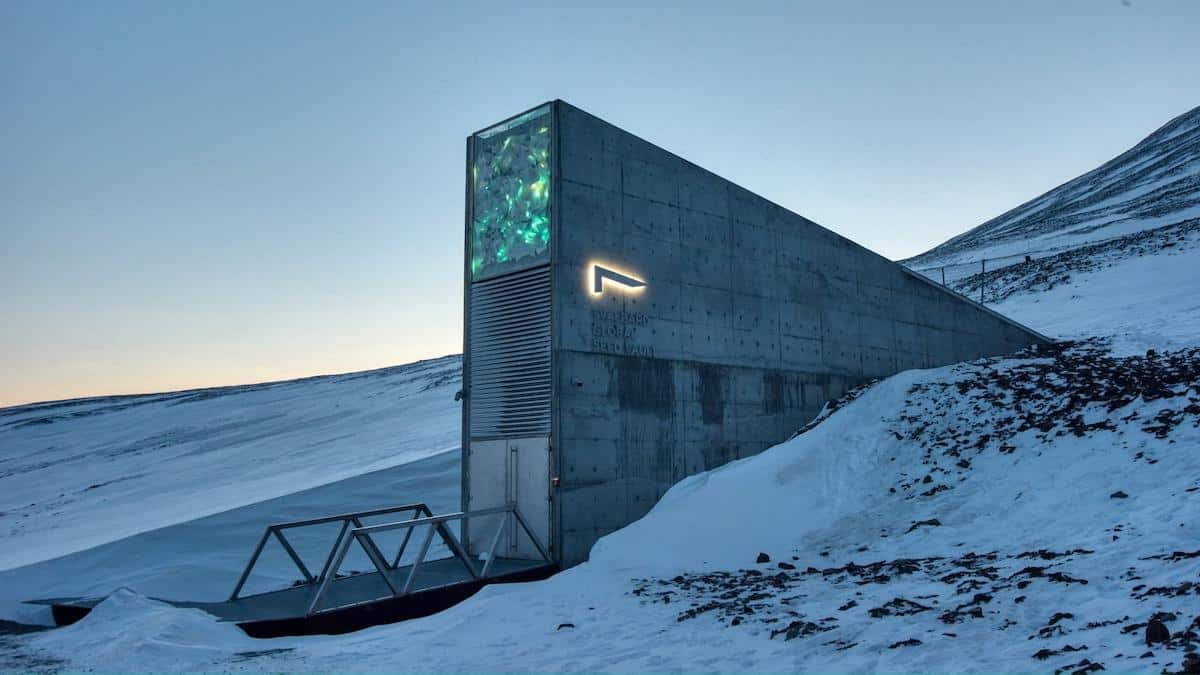

The Svalbard Global Seed Vault in Norway intends to insure against climate disaster. Riccardo Gangale / Flickr
By Tim Radford
London, 15 February, 2021. Bill Gates − yes, that Bill Gates − has for years been financing studies in geo-engineering: he calls it a “Break Glass in Case of Emergency” kind of tool.
But he also says, in a new book, How to Avoid a Climate Disaster: the Solutions We Have and the Breakthroughs We Need, that he has put much more money into the challenge of adapting to and mitigating climate change − driven by global heating powered by greenhouse emissions that are a consequence of our dependence on fossil fuels.
The founder of Microsoft, now a philanthropist, says all geo-engineering approaches − to dim the sunlight, perhaps, or make clouds brighter − turn out to be relatively cheap compared with the scale of the problems ahead for the world. All the effects are relatively short-lived, so there might be no long-term impacts.
But the third thing they have in common is that the technical challenges to implementing them would be as nothing compared with the political hurdles such ambitions must face.
Not for Dummies
There are some very encouraging things about this disarming book, and one of them is that on every page it addresses the messy uncertainties of the real world, rather than an ideal set of solutions.
People who have already thought a lot about the hazards and complexities of global temperature rise might be tempted to dismiss it as Climate Change for Dummies. They’d be wrong.
First, Gates addresses a global audience that includes (for instance) U.S. Republican voters, fewer than one in four of whom understand that climate change is a consequence of what humans have done.
Then Gates writes as an engineer. He starts from the basics and arrives swiftly and by the shortest route at a series of firm conclusions: sophisticated, but still outlined with considerable clarity and a happy trick of pinning big answers to down-to-earth analogies.
Crude oil, he calculates, “is cheaper than a soft drink.” By mid-century “climate change could be just as deadly as Covid-19, and by 2100 it could be five times as deadly.”
And population growth creates prodigious demands: by 2060, the world’s building stock will double. “That’s like putting up another New York City every month for 40 years.”
I call it a disarming book: yes, he concedes that the world is not lacking in rich men with big ideas about what other people should do; yes, he flew a private plane to the Paris Conference in 2015. He doesn’t deny being a rich guy with an opinion and an “absurdly high” carbon footprint. But he believes it is an informed opinion, and he’s always trying to learn more.
And then he gets on with clarifying the big challenges. Yes, there’s no choice: the world has to get to zero-carbon. It’s going to be difficult to achieve the technologies, the political will, the international consensus. Humans have to accomplish something gigantic, much faster than anything ever done before.
Simple Message
He turns to the details: the questions that need to be addressed; the separate problems of electrical energy, of manufacture, of diet and agriculture, of transport, of adaptation; government policy, citizen choice and so on.
He touches on biofuels, nuclear power (“this might sound self-serving, given that I own an advanced nuclear company”), global development, global health, international co-operation and individual choices, all with the same brisk clarity. There already exists a huge literature of climate change: this is a useful addition.
That may be because he keeps the message simple from the start. Right now humans add 51 billion tons of greenhouse gases to the atmosphere every year. To avoid the worst effects of climate change, we have to emit none.
“There are two numbers you need to know about climate change,” he writes in his opening sentences. “The first is 51 billion. The second is zero.”
Reposted with permission from Climate News Network.
- 12 New Books Explore Fresh Approaches to Act on Climate Change ...
- New and Recent Books About Hope in a Time of Climate Change ...
- Bill Gates Says Wealtheir Countries Should Switch to Plant-Based Beef - EcoWatch

 233k
233k  41k
41k  Subscribe
Subscribe 